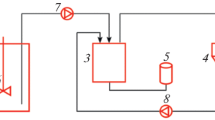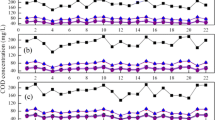Abstract
In this study, an anaerobic/anoxic/oxic (A2O) wastewater treatment process was implemented to treat domestic wastewater with short-term atrazine addition. The results provided an evaluation on the effects of an accidental pollution on the operation of a wastewater treatment plant (WWTP) in relation to Chemical Oxygen Demand (COD) and biological nutrient removal. Domestic wastewater with atrazine addition in 3 continuous days was treated when steady biological nutrient removal was achieved in the A2O process. The concentrations of atrazine were 15, 10, and 5 mg·L−1 on days 1, 2 and 3, respectively. The results showed that atrazine addition did not affect the removal of COD. The specific NH4 + oxidation rate and NO3 − reduction rate decreased slightly due to the short-term atrazine addition. However, it did not affect the nitrogen removal due to the high nitrification and denitrification capacity of the system. Total nitrogen (TN) removal was steady, and more than 70% was removed during the period studied. The phosphorus removal rate was not affected by the short-term addition of atrazine under the applied experimental conditions. However, more poly-hydroxy-alkanoate (PHA) was generated and utilized during atrazine addition. The results of the oxygen uptake rate (OUR) showed that the respiration of nitrifiers decreased significantly, while the activity of carbon utilizers had no obvious change with the atrazine addition. Atrazine was not removed with the A2O process, even via absorption by the activated sludge in the process of the short-term addition of atrazine.
Similar content being viewed by others
References
Kauffmann C, Shoseyov O, Shpigel E, Bayer E A, Lamed R, Shoham Y, Mandelbaum R T. Novel methodology for enzymatic removal of atrazine from water by CBD-fusion protein immobilized on cellulose. Environmental Science & Technology, 2000, 34(7): 1292–1296
Graymore M, Stagnitti F, Allinson G. Impacts of atrazine in aquatic ecosystems. Environment International, 2001, 26(7–8): 483–495
Nalina S, Elizabeth D. A review of epidemiologic studies of triazene herbicides and cancer. Critical Reviews in Toxicology, 1997, 27(6): 599–613
Ma J, Graham N J D. Degradation of atrazine by manganese-catalysed ozonation: Influence of humic substances. Water Research, 1999, 33(3): 785–793
Liu C, Huang X, Wang H. Start-up of a membrane bioreactor bioaugmented with genetically engineered microorganism for enhanced treatment of atrazine containing wastewater. Desalination, 2008, 231(1–3): 12–19
Campos C, Snoeyink V L, Mariñas B, Baudin I, Lainé JM. Atrazine removal by powdered activated carbon in floc blanket reactors. Water Research, 2000, 34(16): 4070–4080
APHA, Standard Methods for the Examination of Water and Wastewater, 20th ed. American Public Health Association, Washington, DC, USA, 1998
Pijuan M, Baeza J A, Casas C, Lafuente J. Response of an EBPR population developed in an SBR with propionate to different carbon sources. Water Science & Technology, 2004, 50(10): 131–138
Wang J, Wu L, Qi X, Qian Y. Characterization of nitrification activity of activated sludge by oxygen uptake rate (OUR). ACTA Scientiae Circumstantiae, 1999, 19(3): 225–229 (in Chinese)
Liu C, Huang X, Sun W, Wang H. Bioaugmentation treatment of atrazine in MBR using genetically engineered microorganism (GEM). Environmental Science, 2007, 28(2): 417–421 (in Chinese)
Downing H F, Delorenzo M E, Fulton M H, Scott G I, Madden C J, Kucklick J R. Effects of the agricultural pesticides atrazine, chlorothalonil, and endosulfan on South Florida microbial assemblages. Ecotoxicology, 2004, 13(3): 245–260
Seviour R J, Mino T, Onuki M. The microbiology of biological phosphorus removal in activated sludge systems. FEMS Microbiology Reviews, 2003, 27: 99–127
Smolders G J F, van der Meij J, van LoosdrechtMC M, Heijinen J J. Model of the Anaerobic Metabolism of the Biological Phosphorus Removal Process: Stoichiometry and pH Influence. Biotechnology & Bioengineering, 1994, 43: 461–470
Crocetti G R, Hugenholtz P, Bond P L, Schuler A, Keller J, Jenkins D, Blackall L L. Identification of polyphosphate accumulating organisms and design of 16S rRNA-directed probes for their detection and quantitation. Applied and Environmental Microbiology, 2000, 66(3): 1175–1182
Bouchez T, Patureau D, Dabert P, Wagner M, Delgenès J P, Moletta R. Successful and unsuccessful bioaugmentation experiments monitored by fluorescent in situ hybridization. Water Science & Technology, 2000, 41(12): 61–68
Shapir N, Mandelbaum R T, Fine P. Atrazine mineralization by indigenous and introduced Pseudomonas sp. strain ADP in sand irrigated with municipal wastewater and amended with composted sludge. Soil Biology & Biochemistry, 2000, 32(7): 887–897
Yuan Z, Blackall L L. Sludge population optimisation: a new dimension for the control of biological wastewater treatment systems. Water Research, 2002, 36(2): 482–490
Liu C, Huang X, Wang H. The biotransformation of atrazine and influence factors by genetically engineered microorganism. Microbiology, 2007, 34(1): 10–14 (in Chinese)
Author information
Authors and Affiliations
Corresponding author
Rights and permissions
About this article
Cite this article
Wu, C., Peng, Y., Li, X. et al. Effect of short-term atrazine addition on the performance of an anaerobic/anoxic/oxic process. Front. Environ. Sci. Eng. China 4, 150–156 (2010). https://doi.org/10.1007/s11783-010-0020-9
Received:
Accepted:
Published:
Issue Date:
DOI: https://doi.org/10.1007/s11783-010-0020-9




